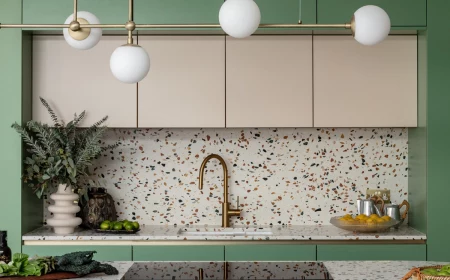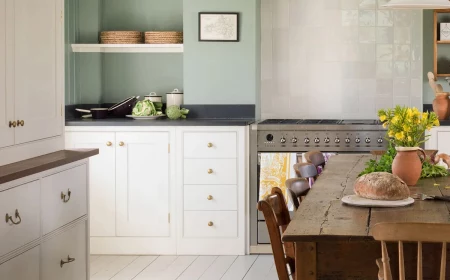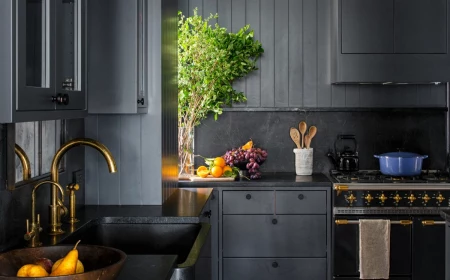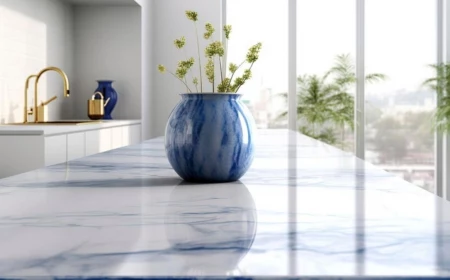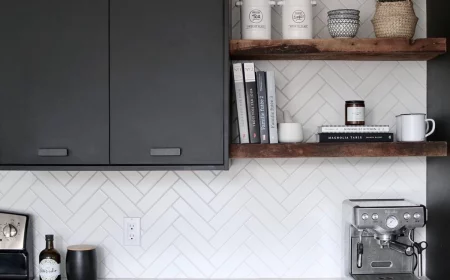A Rustic Kitchen That’s Actually Built to Last: Here’s How
I’ve spent a good chunk of my life with my hands on wood, stone, and metal. And I’ve seen the term “rustic” get thrown around a lot. So often, it just means slapping a barn door on a pantry or hanging a few signs that say “Gather.” But to me, a truly rustic kitchen isn’t a theme you buy at a big-box store. It’s a feeling. It’s about solid materials that do their job, function that makes sense for your life, and a warmth that feels earned, not faked.
In this article
Honestly, it’s a space that should feel lived-in and welcoming from day one. When I talk to people about creating a kitchen like this, we don’t start with paint chips. We start with how they live. Do you host big, messy family dinners? Do you bake bread and need a countertop that can take a beating? This guide is built on all the lessons learned the hard way—like the time I saw gorgeous, expensive reclaimed wood warp and buckle because it wasn’t given time to get used to its new home. It’s everything I’d share about building a kitchen that’s not just beautiful, but built for life.
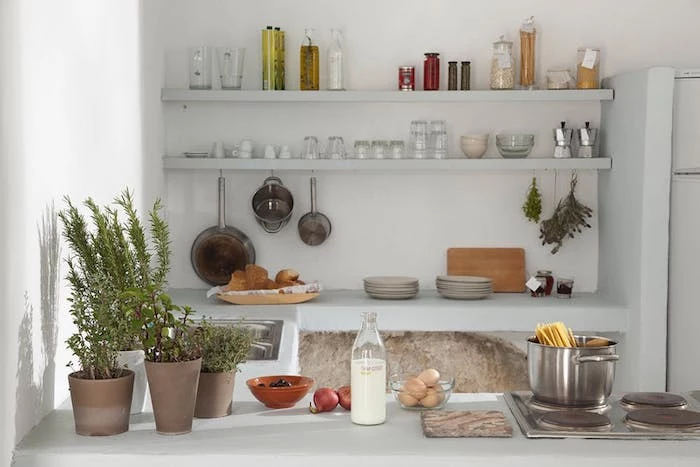
The Soul of a Rustic Kitchen: Its Materials
The first step is understanding why certain materials just feel right. A great rustic kitchen works because every part of it is honest. It’s all about celebrating the real character of wood, stone, and metal—imperfections and all.
Wood: The Heartbeat of the Room
Wood is almost always the star of the show. But the type of wood you pick really changes the story. Oak is a classic for a reason: it’s tough, durable, and has a strong, handsome grain perfect for cabinets and floors. Pine is a softer soul; it picks up dings and scratches over time, which becomes part of its charm. Then you have hickory, which is incredibly hard and often has these beautiful, wild color swings from pale cream to deep brown, sometimes all in one board.
But here’s the most important thing to know about wood: it’s alive. It breathes. Wood expands when it’s humid and shrinks when it’s dry. Good design has to account for this. It’s why wide plank floors need a small expansion gap around the edge of the room, tucked away under the baseboards. It’s why a classic inset cabinet door (the kind that sits inside the frame) needs a perfect, consistent gap around it—I usually aim for the thickness of two dimes—so it doesn’t jam shut in the middle of a humid summer.
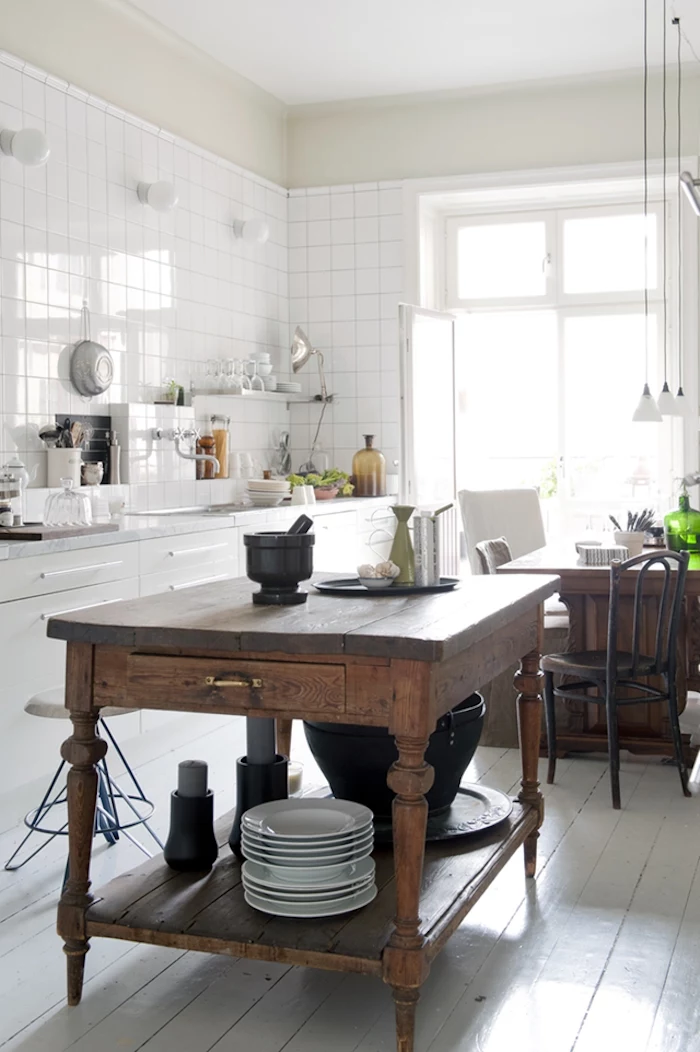
Oh yeah, and about that beautiful reclaimed wood from an old barn? It has a soul you just can’t replicate. But it’s a project. Before it can be used, it needs to be checked for old nails and bugs, and often kiln-dried to get its moisture content stable. And then—this is the step people always skip—it has to sit inside your house for at least two weeks to acclimate. I’ll never forget a client who bought stunning barnwood online and had it installed immediately. A month later, in the dry winter air, it had shrunk so much there were quarter-inch gaps between the boards. A little patience would have saved them thousands.
Stone: That Grounded, Earthy Feel
Stone is what connects your kitchen to the ground. Slate, soapstone, and travertine are all fantastic choices. Slate is dense and splits into these lovely flat layers, which makes it an amazing (and durable) flooring option. Soapstone is my personal favorite for countertops around a stove. It’s non-porous, so it doesn’t stain easily and you don’t have to seal it. Plus, it has a soft, almost warm-to-the-touch feeling that’s totally different from granite.
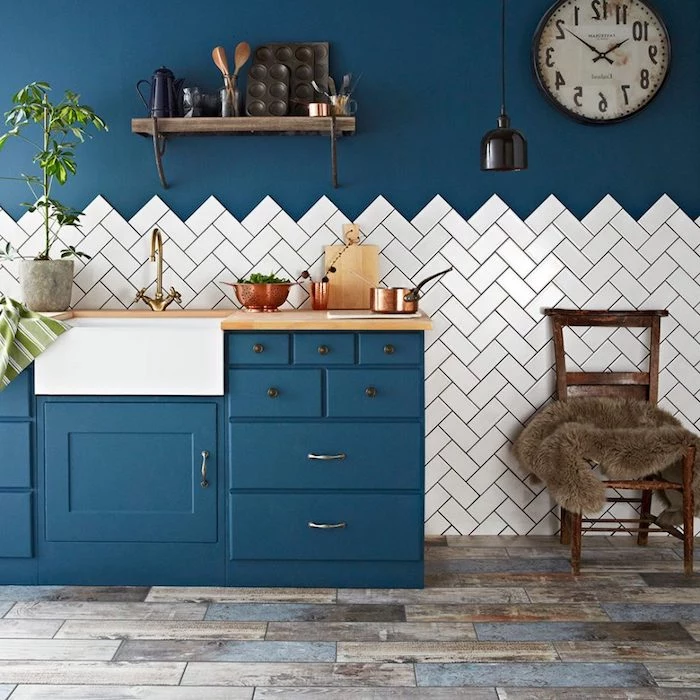
A cool thing about stone is its thermal mass, which means it absorbs and holds onto heat. In the summer, a thick stone floor feels blissfully cool. In the winter, though… it can be chilly. For homes in colder climates, we often sneak in some radiant heating coils underneath to give you that cozy, warm-toes feeling. Price-wise, you’re looking at a real range. A nice slate for flooring might cost you $10-$25 per square foot just for the material, while that beautiful soapstone countertop will run closer to $100-$200 per square foot, installed.
Metal: For Accents That Age Gracefully
In a rustic space, you want metals that get better with age. Forget the shiny chrome. We’re looking for a beautiful, natural patina. Wrought iron is perfect for things like cabinet pulls, pot racks, and light fixtures. Its slightly uneven surface catches the light in a way mass-produced hardware just can’t. Copper is another great choice, especially for sinks and range hoods. It starts out bright and coppery but quickly develops this deep, rich brown patina from simply reacting with the air. A nice bonus I always mention: copper is naturally antimicrobial, which is a pretty great feature for a kitchen sink.
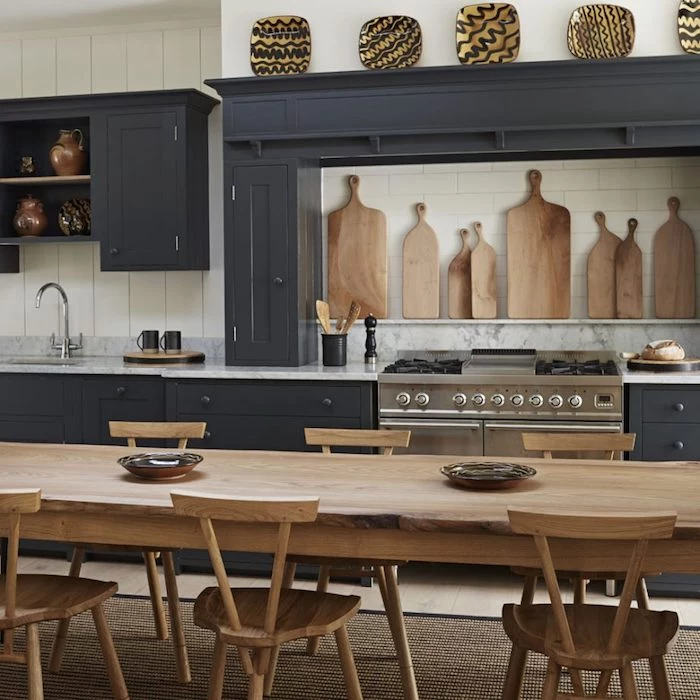
How the Pros Build the Key Components
Getting that authentic feel comes down to the techniques. It’s the little details that separate a standard kitchen from one with real character.
Cabinetry: More Than Just Boxes
Properly built rustic cabinets often use what’s called a framed construction, with a solid wood face frame that gives them strength and a timeless look. For the doors, an inset style, where the door sits perfectly flush inside the frame, is the most authentic choice. It takes precision, but it’s worth it.
The finish is everything. Instead of a thick, plastic-feeling lacquer, we might use something like milk paint, which soaks into the wood and chips and wears gently over the years. For a natural wood look, nothing beats a hand-rubbed oil finish. It’s a bit more work—you’ll need to reapply a coat every year or so—but the trade-off is that you can feel the actual wood grain. Plus, repairs are a breeze. You can lightly sand out a scratch and re-oil just that spot, and it will blend right in, which is impossible with a factory finish.
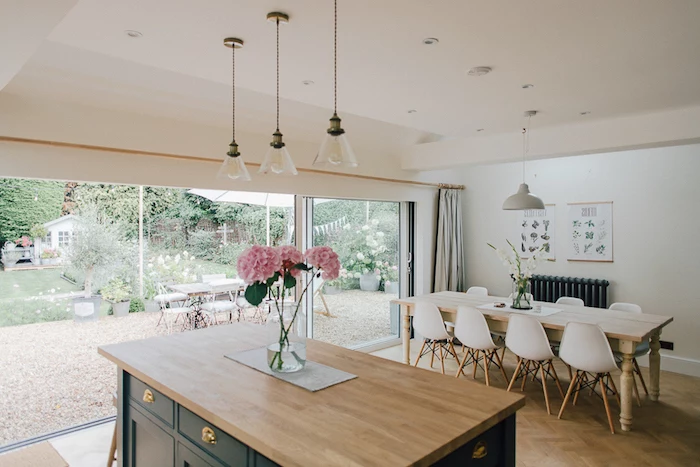
Countertops: Your Kitchen’s Workhorse
Your countertop choice has a huge impact on how you use your kitchen every day.
For wood countertops, a classic butcher block is a warm and forgiving surface. Hard maple and walnut are excellent choices. You can get it in two main styles: edge grain (made from long strips) or end grain (which shows the wood’s growth rings). End grain is tougher and you can chop directly on it, but it also costs more and takes more work to build. Expect to pay around $50-$100 per square foot for a good butcher block, but a fancy end-grain walnut could easily be double that. Heads up! Water is the enemy. For any wood counter with a sink, you absolutely must use a marine-grade varnish for about 18 inches on either side to prevent rot.
How to Re-oil Your Wood Countertop: It’s easier than you think. Once a month, just clear everything off, give it a quick clean with gentle soap, and let it dry completely. Then, pour on a generous amount of food-grade mineral oil (you can get it at most hardware stores for under $10) and spread it around with a clean cloth. Let it soak in for at least 20 minutes, then wipe off any excess. The wood will look so much richer.
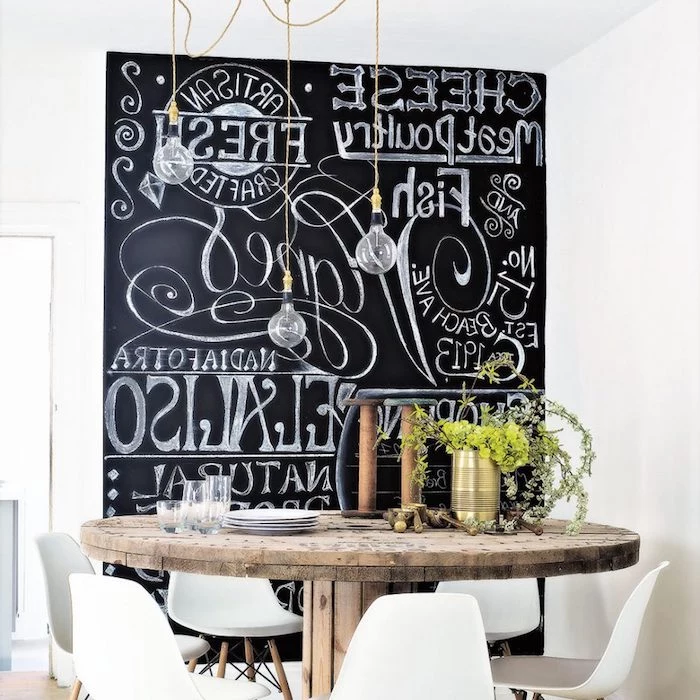
For stone countertops, the pros always make a full-size template out of thin plywood first. Why? Because your walls are never perfectly straight. For a rustic look, ask for a honed or leathered finish instead of polished. A honed finish is matte and smooth, while a leathered one has a subtle texture that feels amazing. With the exception of soapstone, most stone needs to be sealed. Not sure if it’s time to reseal? Leave a drop of water on the surface for 10 minutes. If it leaves a dark spot, it’s time.
If you do get a dreaded oil stain, you can try making a poultice. Just mix up a thick paste, about the consistency of peanut butter, using baking soda and a little water. Spread it on the stain, cover it with plastic wrap, and let it sit for a day. Sometimes, it works like magic and pulls the oil right out.
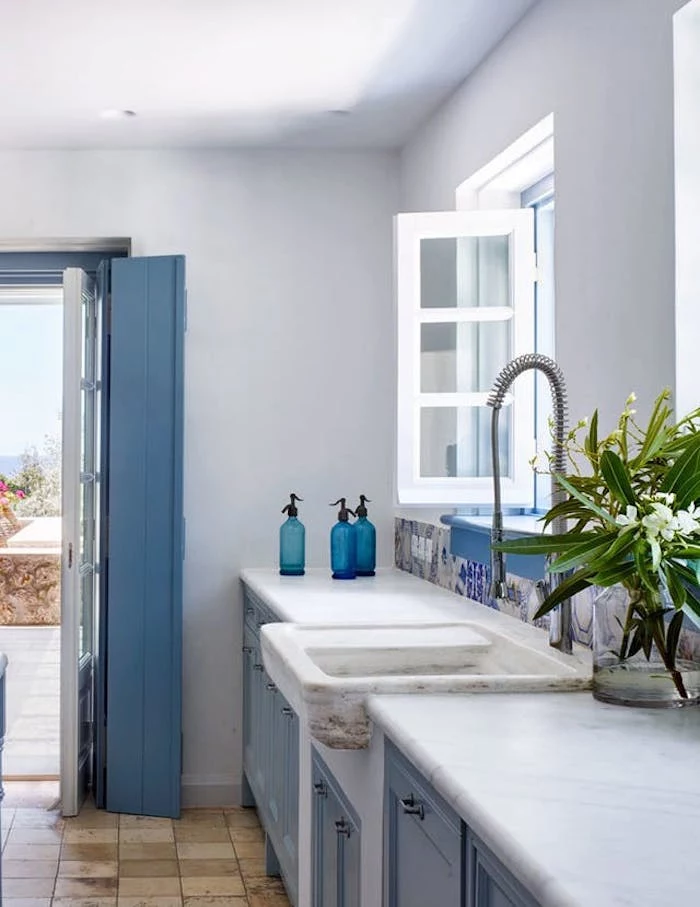
Flooring: The Foundation of It All
Wide plank wood flooring is the go-to. For a really authentic look, solid wood is nailed directly to the subfloor. To handle that seasonal wood movement we talked about, a good installer might leave a tiny gap—about the width of a nickel—between some of the boards to give them room to breathe.
If you’re going with stone floors like slate, your subfloor needs to be rock-solid to prevent cracks. We always, always install an uncoupling membrane first. It’s a sheet of polyethylene, often bright orange, that looks kind of like a plastic waffle (a common brand is Schluter-DITRA). It sits between the subfloor and the stone, allowing them to move independently. This is a non-negotiable step for a job that’s built to last.
What’s Your Rustic Vibe?
“Rustic” isn’t a single look. It’s a whole family of styles, each with its own personality. Which one feels like you?
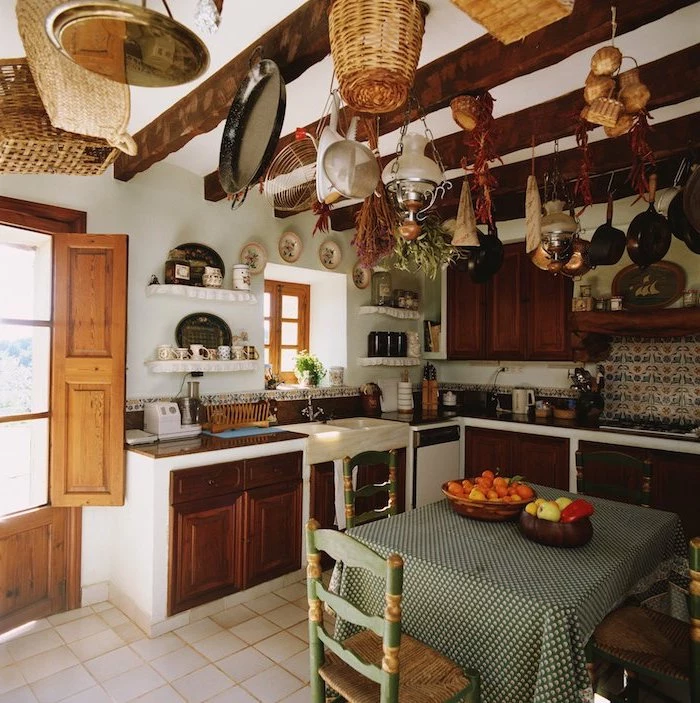
- American Farmhouse: Think pure, simple function. This style has clean lines, painted cabinets (often white or gray), and dark, hardworking countertops like soapstone. That classic apron-front sink was originally designed to be big enough for canning pots. The whole feel is bright, practical, and completely unpretentious.
- Tuscan Countryside: This one is all about warmth and weight. You’ll see terracotta floor tiles that stay cool in the Mediterranean heat, and walls made of textured plaster in sunny yellow or ochre tones. The wood here is usually dark, heavy, and a bit distressed, with plenty of wrought iron and copper.
- French Provincial: This is like the elegant cousin of the other rustic styles. It blends country charm with a little bit of city grace. The colors are softer—pale blues, creams, gentle yellows—and the cabinetry might have subtle curves or simple carvings. It’s lighter and more romantic.
- English Cottage: Defined by pure coziness and charm. This style loves to mix and match. You might find beaded-board paneling on the walls, a few painted cabinets sitting next to natural wood pieces, and maybe even some floral fabrics. The goal is to feel like the room has been lovingly collected over many years.
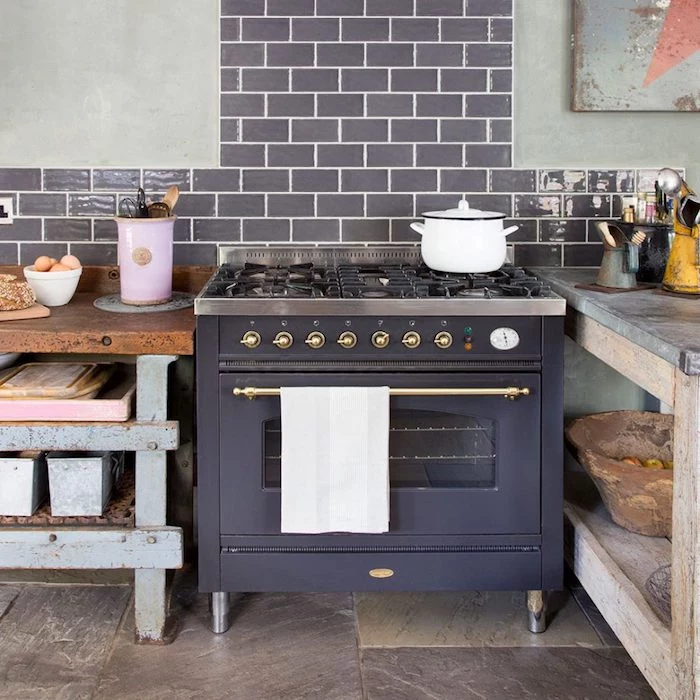
A Practical Plan to Get Started
Whether you’re hiring a pro or doing it yourself, a good plan makes all the difference.
First, think about function. The “kitchen work triangle”—the path between your sink, stove, and fridge—should feel effortless. Try to walk through the steps of making your favorite meal in your head. Where do you put down your groceries? Is the trash can convenient to where you chop vegetables? A beautiful kitchen that’s a pain to cook in is not a success.
When you’re sourcing materials, check out architectural salvage yards for reclaimed wood. And when you find a piece you love, bring a pocket knife. If you can easily push the tip deep into the wood, it might be too soft from rot. When it comes to vintage appliances, be realistic. An old stove from a bygone era is a beautiful machine, but it lacks modern safety features, and finding someone who knows how to fix it can be a nightmare. Honestly, a modern appliance with a retro design is a much safer and more practical compromise for most people.
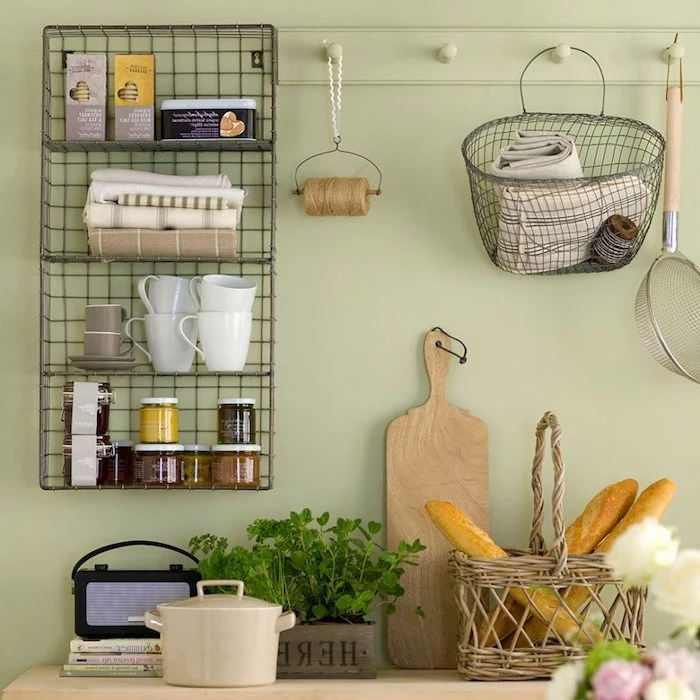
And know when to call for backup. A handy person can definitely tackle tiling a backsplash, painting cabinets, or even installing a butcher block counter. But any work involving gas lines, major electrical rewiring, or moving plumbing inside a wall is a job for a licensed professional. Same goes for installing anything massively heavy. I’ve heard horror stories of people trying to lift a 600-pound stone countertop into place themselves. It is absolutely not worth the risk to your back or your budget.
The Finishing Touches: Hiding the 21st Century
Let’s be real, most of us still want a microwave and a dishwasher. The trick is to integrate them seamlessly. You can get a dishwasher with a custom cabinet panel so it completely disappears. For the microwave, toaster, and coffee maker, I love designing a dedicated “appliance garage”—a cabinet that sits on the countertop—to keep the modern clutter out of sight.

A good range hood is another must-have for air quality. You can hide a powerful, modern ventilation insert inside a beautiful custom hood made of plaster, wood, or copper that’s designed to look like a traditional hearth. You get all the function with none of the stainless-steel clashing.
Final Word: Safety and Long-Term Care
This is the serious part. A kitchen has to be safe. When you have powerful appliances near combustible materials like wood, you have to respect clearances. Building codes usually require at least 30 inches of vertical space between a cooktop and any wood cabinets above it.
Also, don’t underestimate weight. Those stone countertops are incredibly heavy. The cabinets underneath them need to be built to handle that load. If you’re dreaming of adding heavy decorative beams to your ceiling, you absolutely must consult a structural engineer first. They can tell you if your home can handle the extra weight. I once saw a project where a homeowner hung huge antique beams, and a year later, the whole ceiling was visibly sagging. That was an expensive fix.
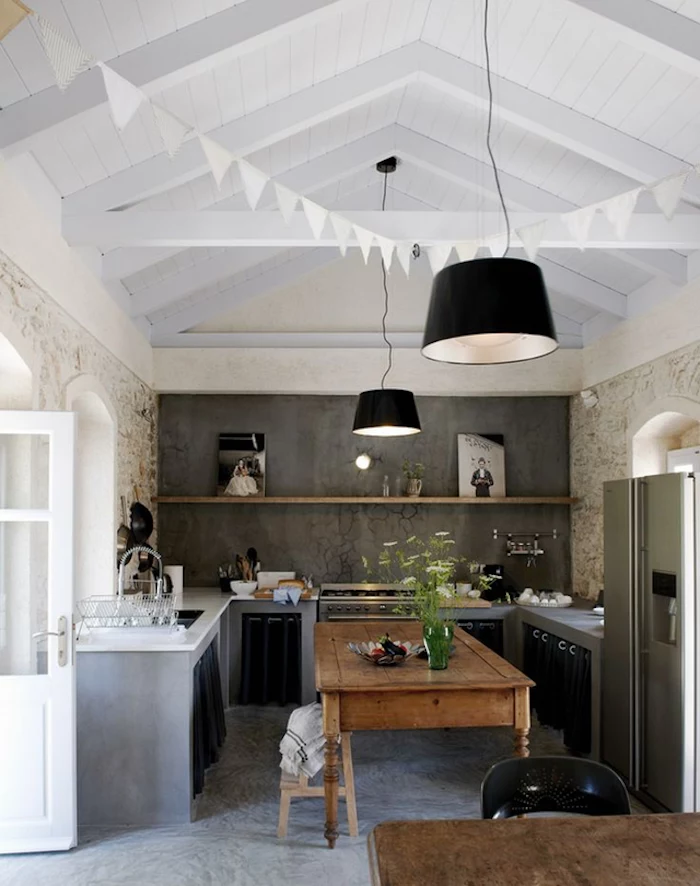
Finally, remember that this is a guide based on years of experience, but every project is unique. Always check your local building codes and work with licensed, insured professionals for the big stuff. A kitchen is a huge investment. Doing it right, with an eye for quality and safety, will give you a space your family will love for years to come.
Inspirational Gallery
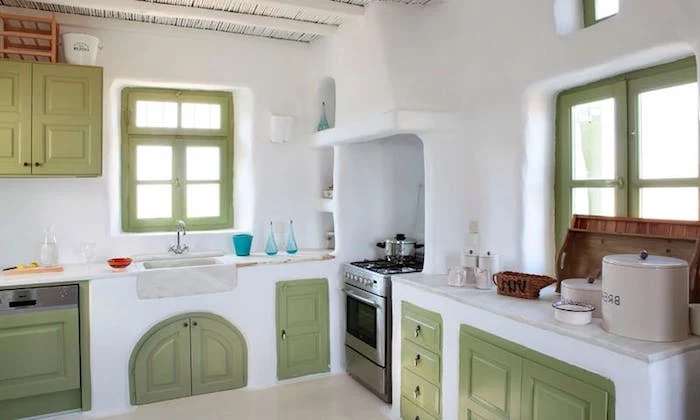
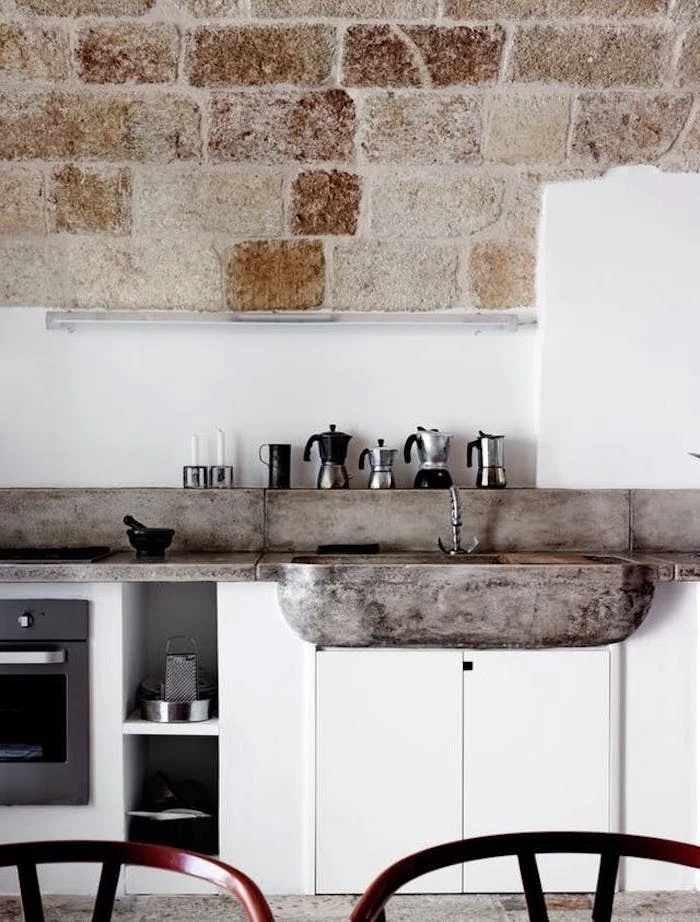
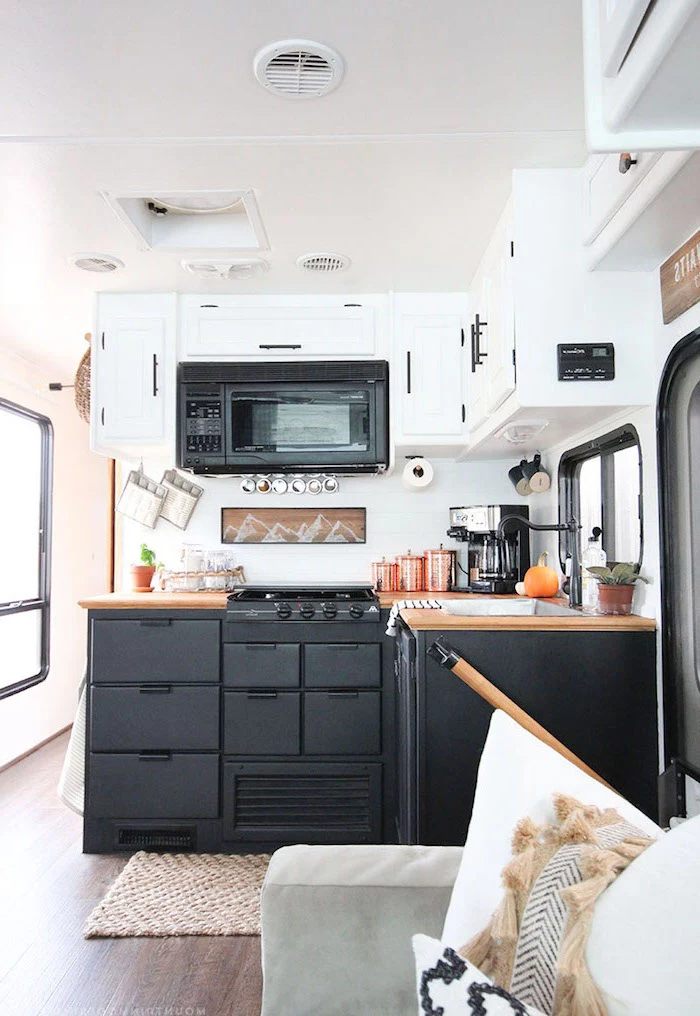
What’s the secret to getting that authentic, aged hardware look?
You can create it yourself. For solid brass, place your new knobs or pulls in a sealed container with a small dish of ammonia (don’t let them touch it); the fumes will create a rich patina in hours. For iron, a light misting of saltwater and a day in the sun will produce authentic rust spots. Just be sure to seal your finished hardware with a clear matte lacquer to stop the process.
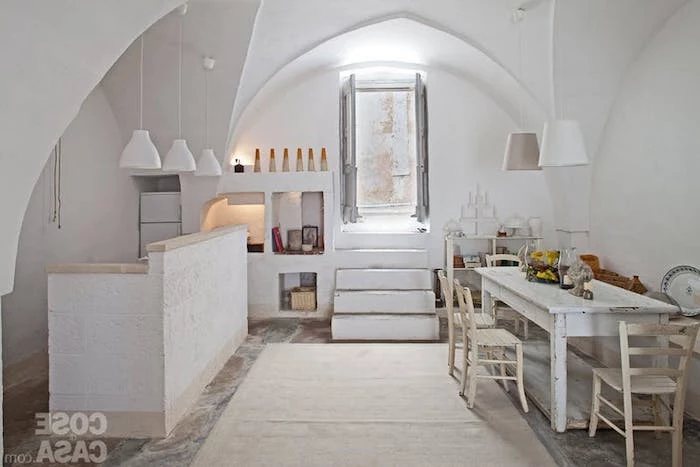

The best rustic kitchens have a sense of place. The materials—be it local fieldstone for a backsplash or timber from a nearby mill for the beams—should tell a story about where you are.
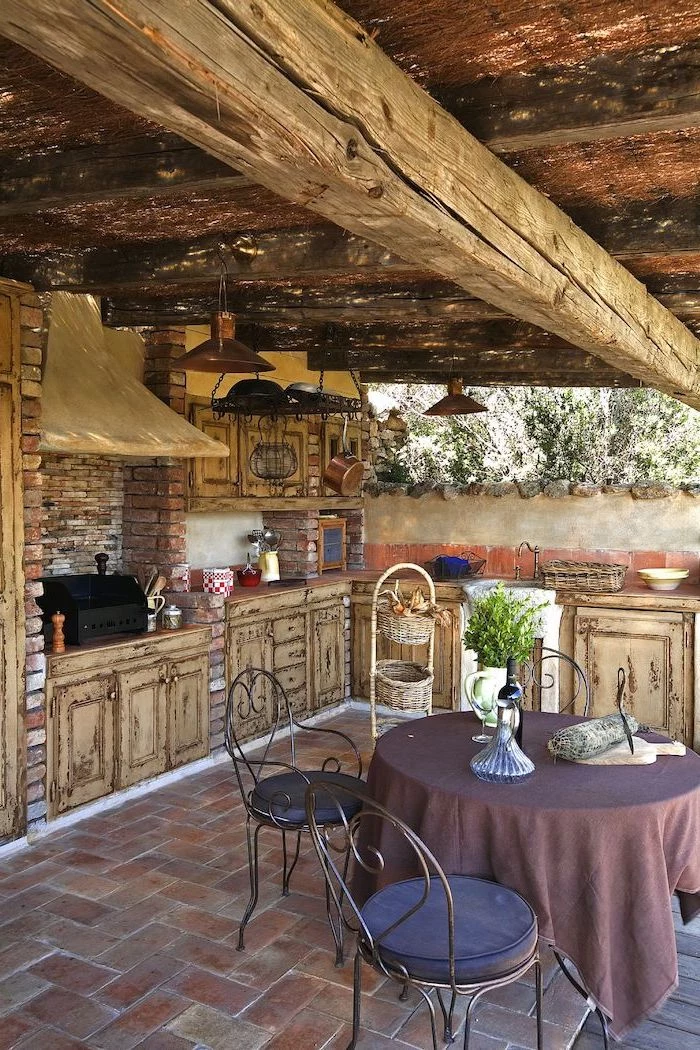

Soapstone vs. Slate Countertops:
Soapstone: A softer, metamorphic rock that feels silky to the touch. It’s non-porous but can scratch. Scratches can be sanded out, and the stone is often treated with mineral oil to develop a deep, dark patina over time.
Slate: Harder and more brittle than soapstone. It has a more uniform, matte finish and is highly resistant to stains and heat. It won’t patina in the same way, offering a more consistent look.
Both offer a fantastic, honest alternative to granite or quartz.

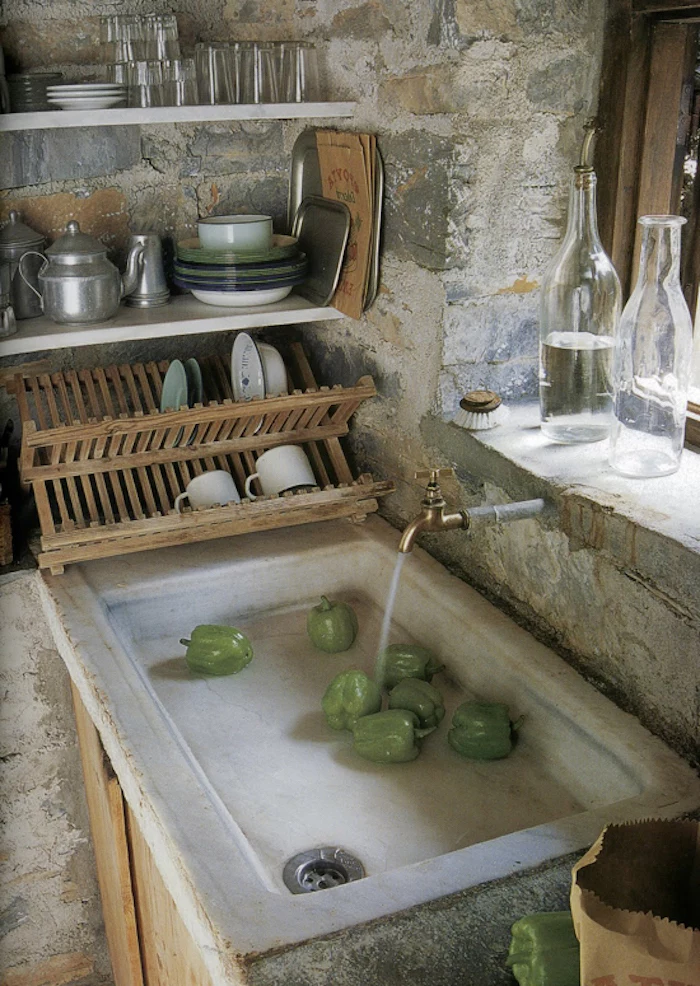
The ‘unfitted kitchen’ concept is central to an authentic rustic feel. Instead of rows of identical built-in cabinets, think of the kitchen as a room furnished with individual pieces. A large Welsh dresser for dishes, a sturdy butcher block table as an island, and a freestanding pantry cupboard create a space that feels as though it has evolved naturally over decades.

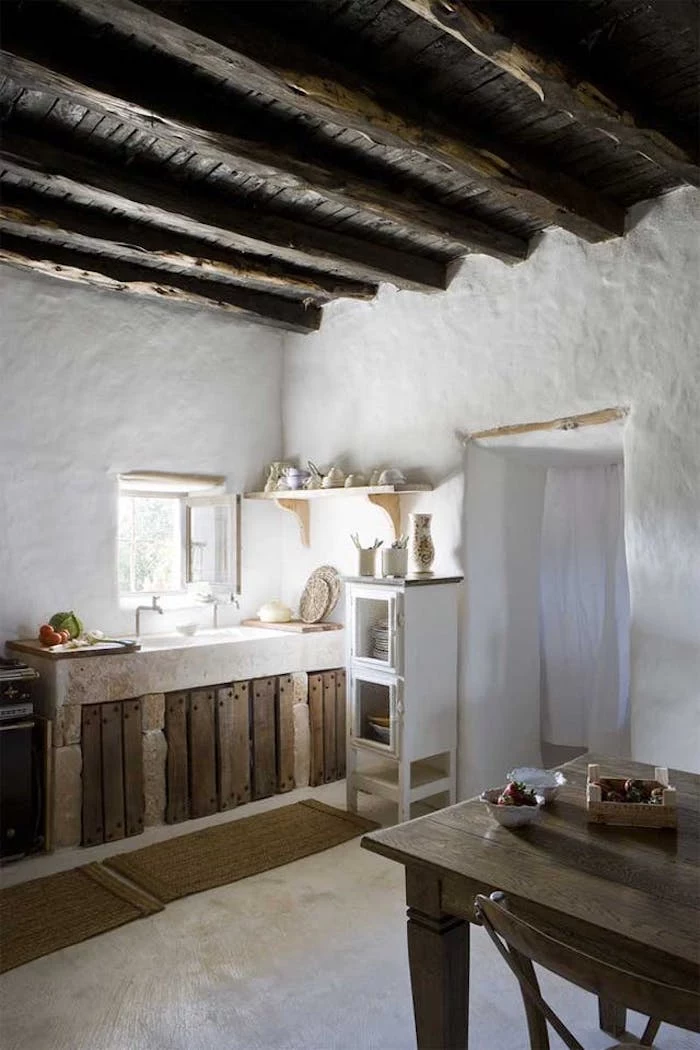
- It adds instant warmth and historic texture.
- It beautifully hides imperfections on an old wall.
- It creates a soft, chalky depth that modern paints can’t replicate.
The secret? A simple limewash finish. Brands like Portola Paints or Bauwerk Colour offer stunning, natural pigments that let your walls breathe and age gracefully.

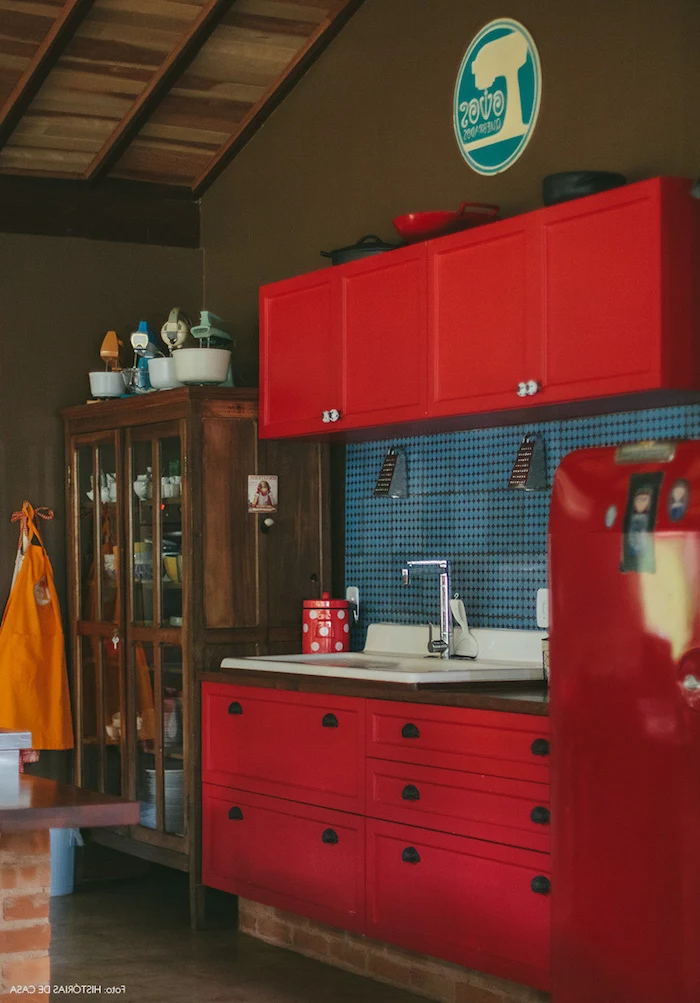
The forgotten sense: Don’t just focus on how a rustic kitchen looks, but how it smells. The subtle scent of beeswax polish on wood, a bundle of dried rosemary hanging from a beam, or the aroma of simmering stock on the stove are what truly transform a space into a welcoming home.
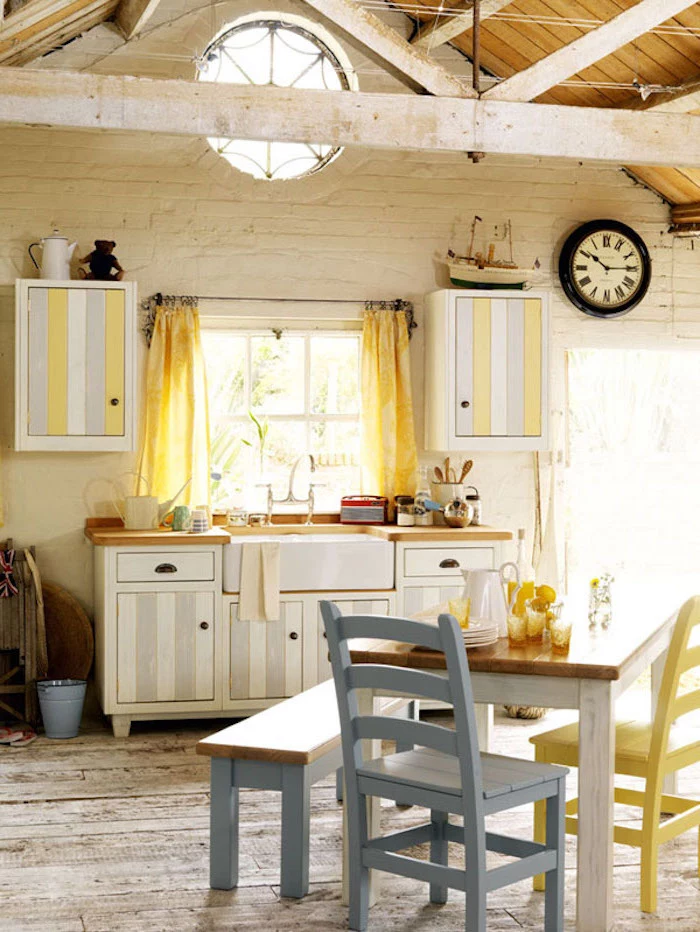
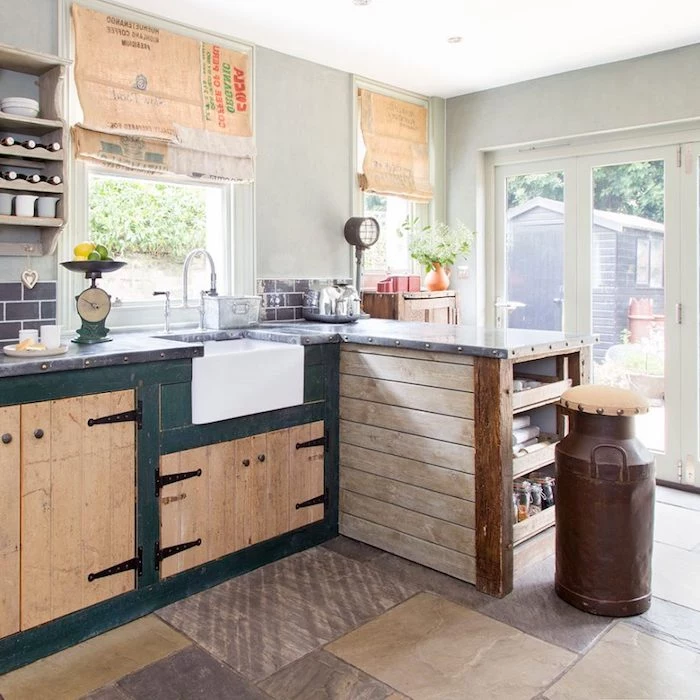
Lighting is about creating pools of warmth. Beyond general overhead light, think in layers:
- Task: Under-cabinet puck lights to illuminate your prep surfaces.
- Accent: A small, shaded lamp on a countertop adds a cozy, living-room feel.
- Focal: A dimmable, antique-style pendant in copper or forged iron over the island or dining table.

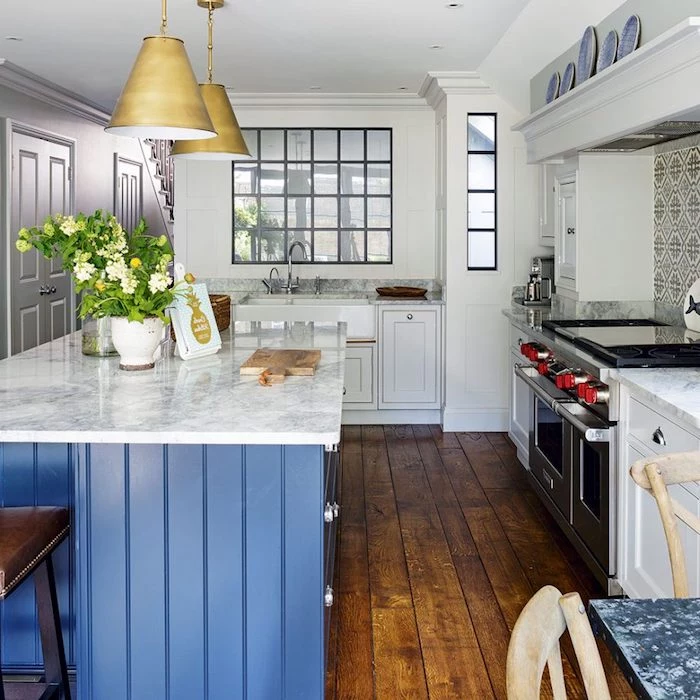
A classic fireclay farmhouse sink, like a Shaws of Darwen Original, can weigh over 100 pounds (45kg).
This isn’t just a fun fact; it’s a critical planning note. Your base cabinet must be properly reinforced with extra vertical supports to handle the substantial weight, ensuring it remains a durable centerpiece for years to come.

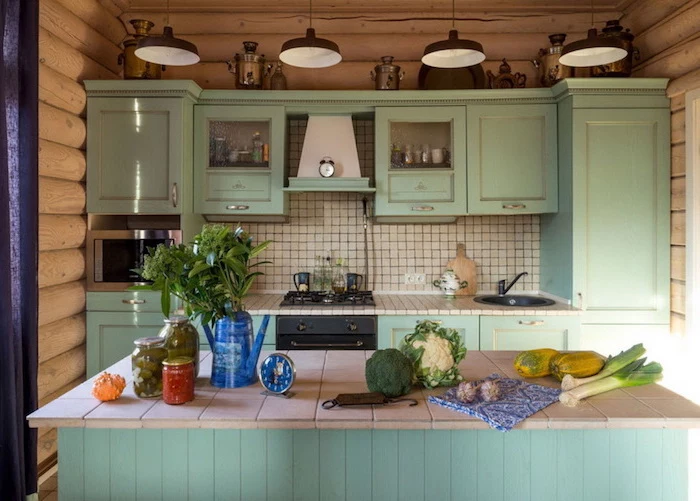
For that authentically ‘chipped’ paint look on cabinets or furniture, forget modern latex paints. The key is to use real milk paint, like from Old Fashioned Milk Paint Co. It’s a natural, non-toxic paint that creates a breathable, matte finish that flakes and ages genuinely over time with use.


Is beadboard a good choice for a rustic backsplash?
Yes, it’s a cost-effective and historically accurate option that adds texture and charm. For kitchen use, install it with a quality construction adhesive and choose a durable, wipeable paint finish like an eggshell or semi-gloss. Most importantly, run a clean bead of silicone caulk where the beadboard meets the countertop to create a waterproof seal.
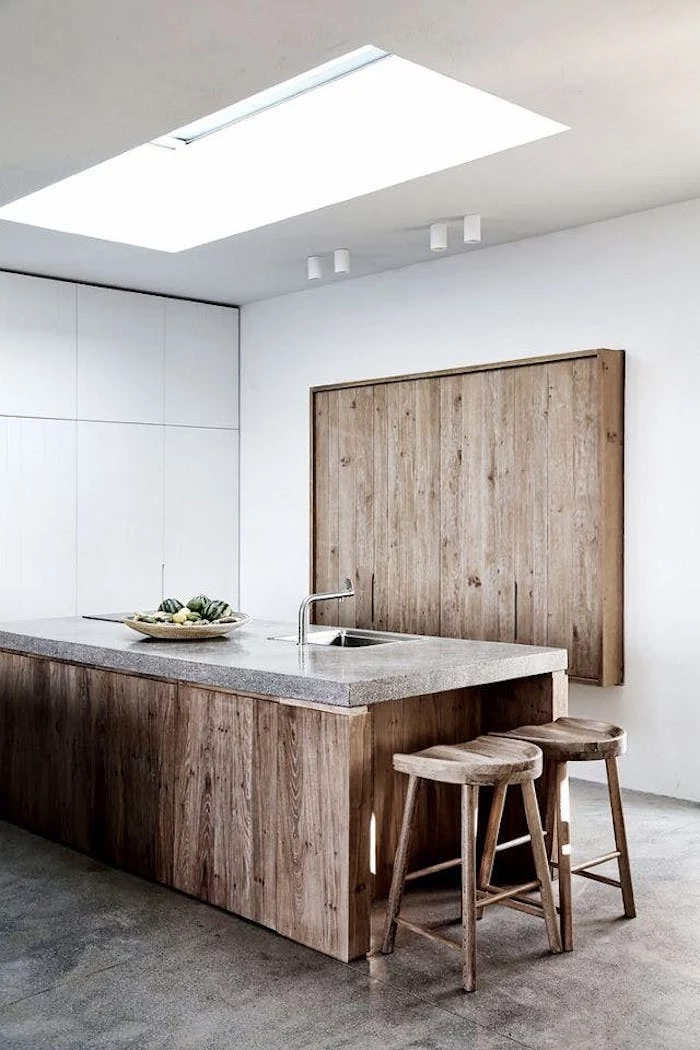
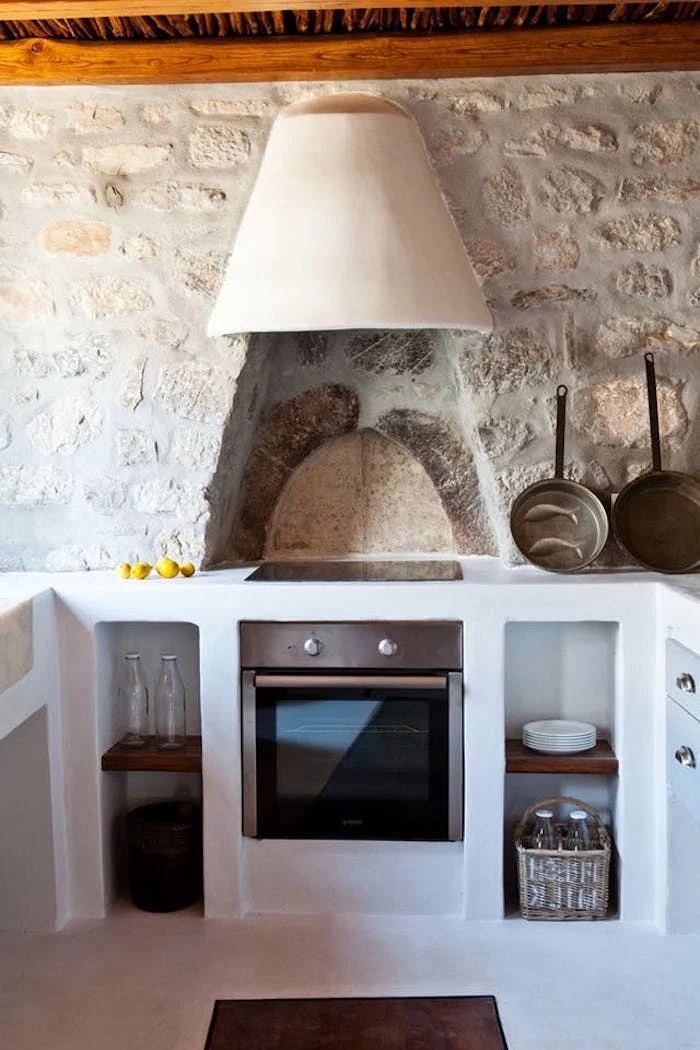
A freestanding range cooker is more than an appliance; it’s a piece of furniture that anchors the entire kitchen. A classic cast-iron Aga or a colorful French model from Lacanche acts as the room’s hearth, radiating both literal warmth and a powerful, enduring presence that defines the space.
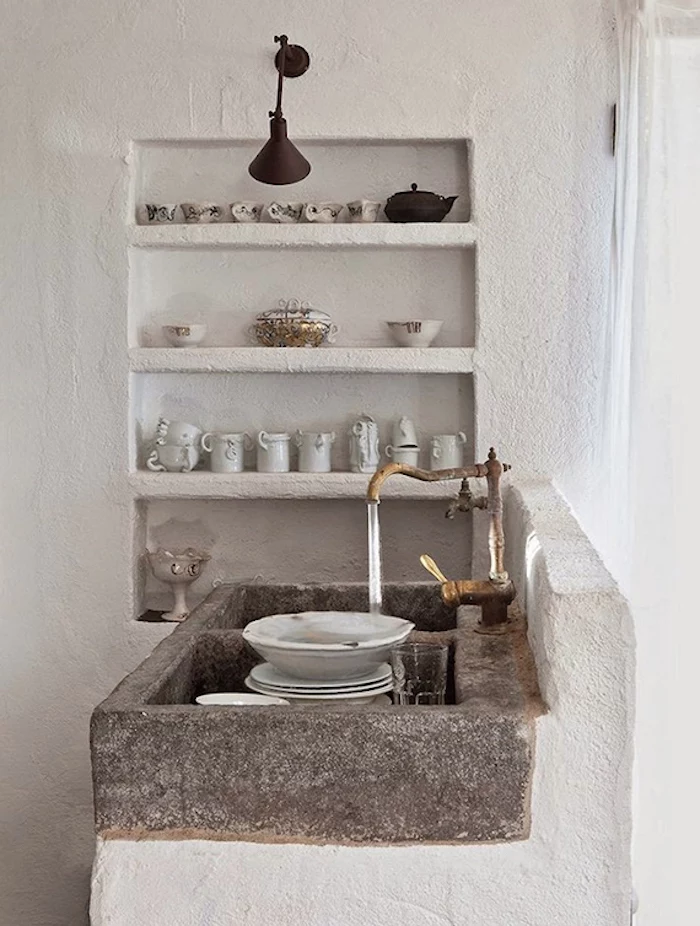
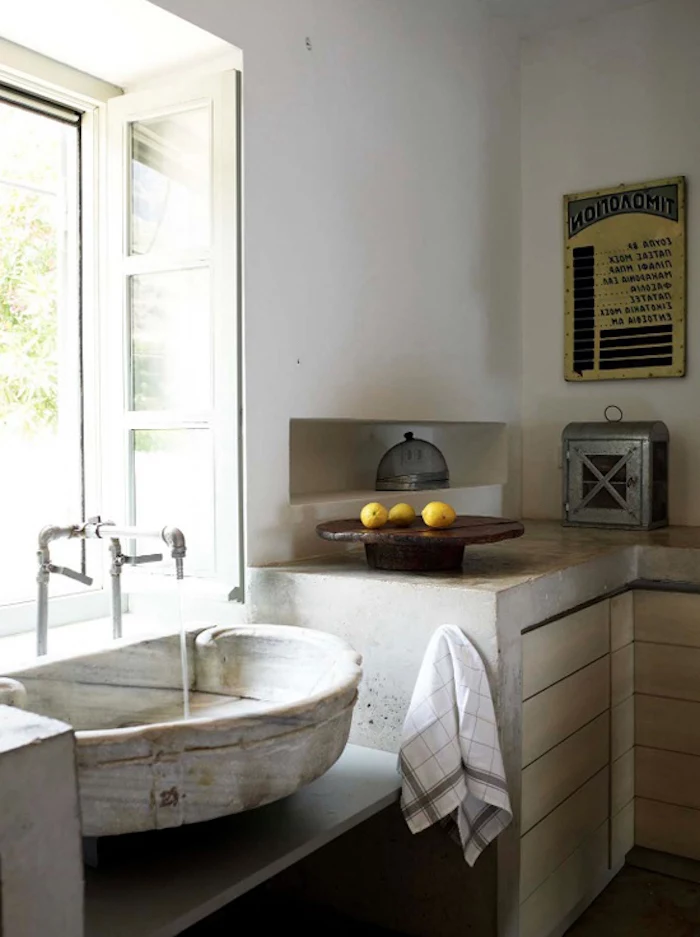
- Large glass Kilner or Weck jars for flour, sugar, and grains.
- Open-weave wire baskets that allow air to circulate around potatoes and onions.
- Simple wooden crates for storing bulk items or root vegetables.
- Chalkboard-paint labels for a reusable, classic organization system.

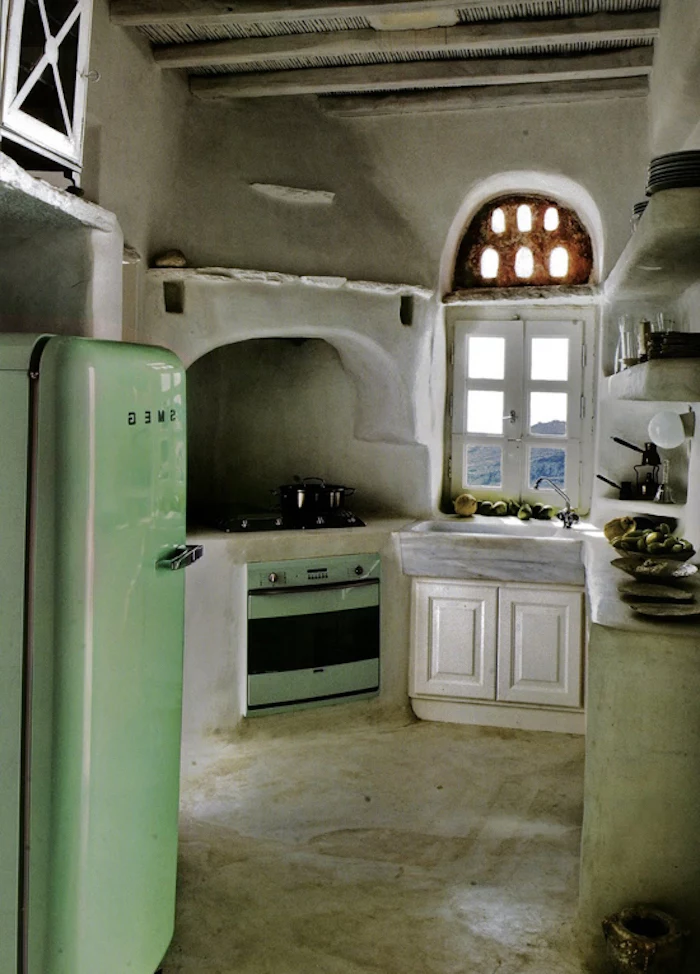
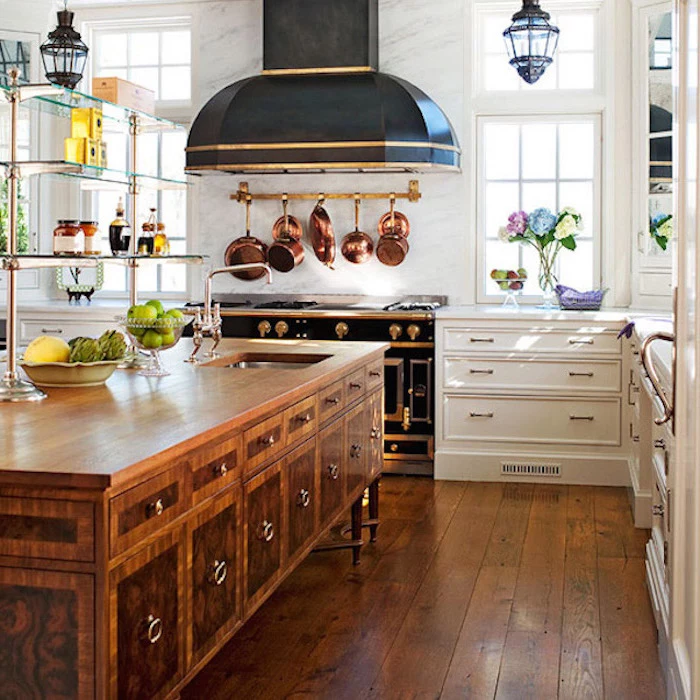
Don’t overlook the floor. Wide-plank reclaimed pine or terracotta tiles are timeless choices that build character with every scuff. For a practical, budget-conscious alternative, consider luxury vinyl tile (LVT) from a brand like Karndean, whose Knight Tile range offers incredibly realistic wood and stone effects with superior water resistance and durability.


Mixing metals is not a mistake; it’s a sign of an evolved, authentic space. The key is to choose a dominant metal and add one or two as accents. For instance, pair an oil-rubbed bronze faucet and cabinet pulls with a statement copper pot rack or zinc-topped island. This intentional variety creates a ‘collected over time’ feel.
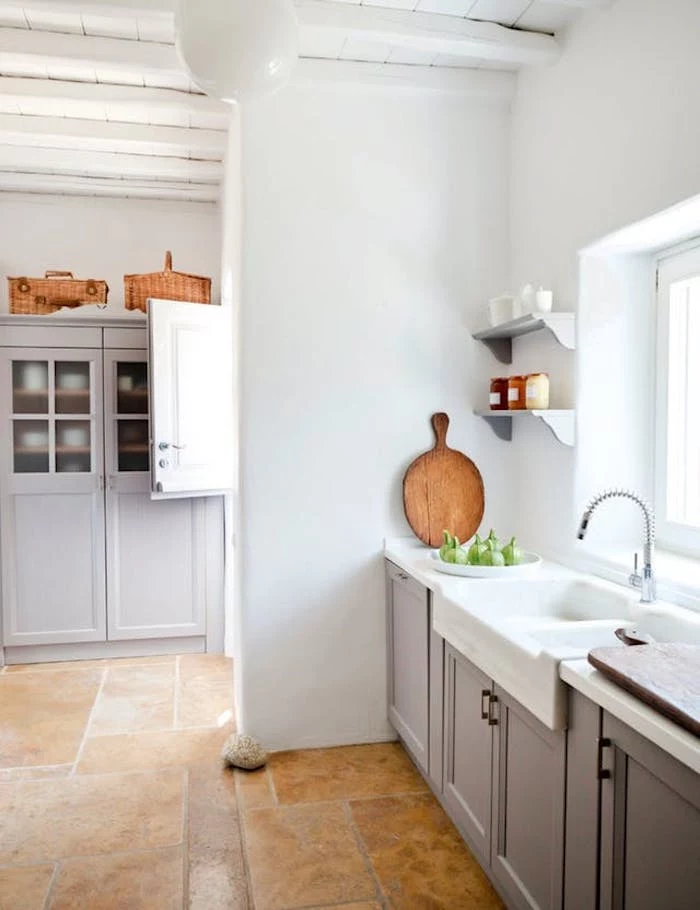
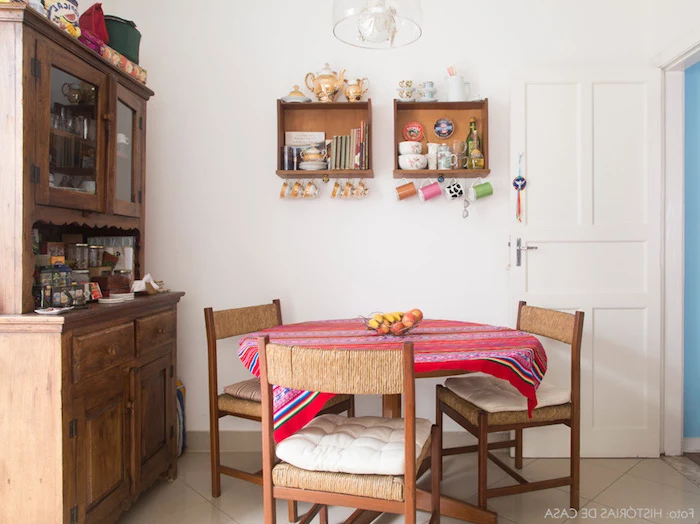
Many reclaimed wood beams pre-date modern forestry, meaning they were harvested from old-growth trees. This wood is often denser and more stable than new lumber.
When sourcing reclaimed wood, always ask about its history and ensure it’s been kiln-dried or properly acclimated to your home’s humidity. This prevents the warping and cracking that the article’s author warned about, allowing you to safely incorporate a piece of history.


The satisfying ‘thunk’ of a heavy, well-made cabinet door is a small detail that signals quality. Achieve this not with soft-close mechanics, but with traditional hardware. Opt for substantial, visible butt hinges and classic cast-iron or brass butterfly latches for a tactile experience that feels as solid as it looks.
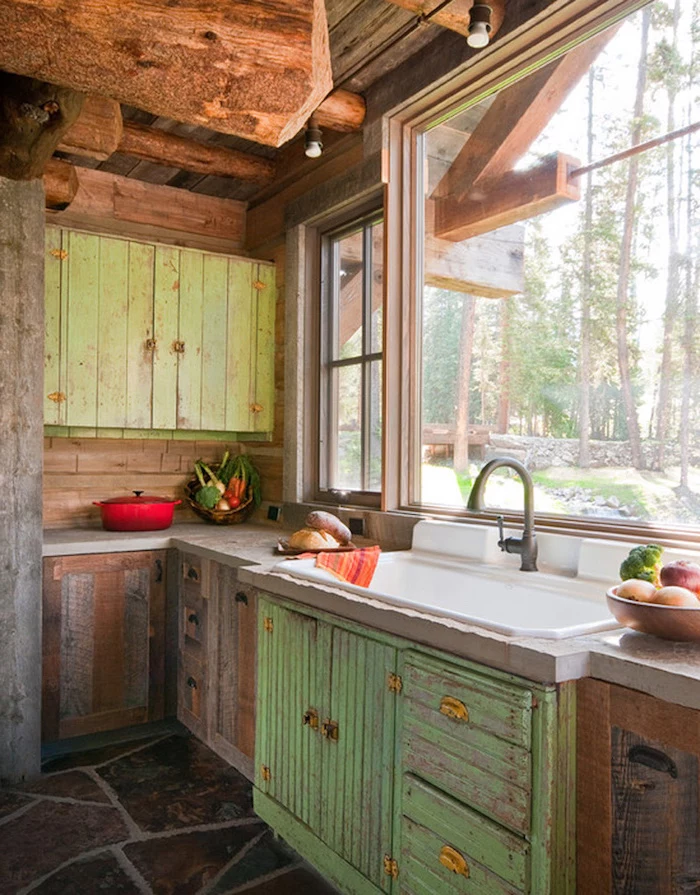
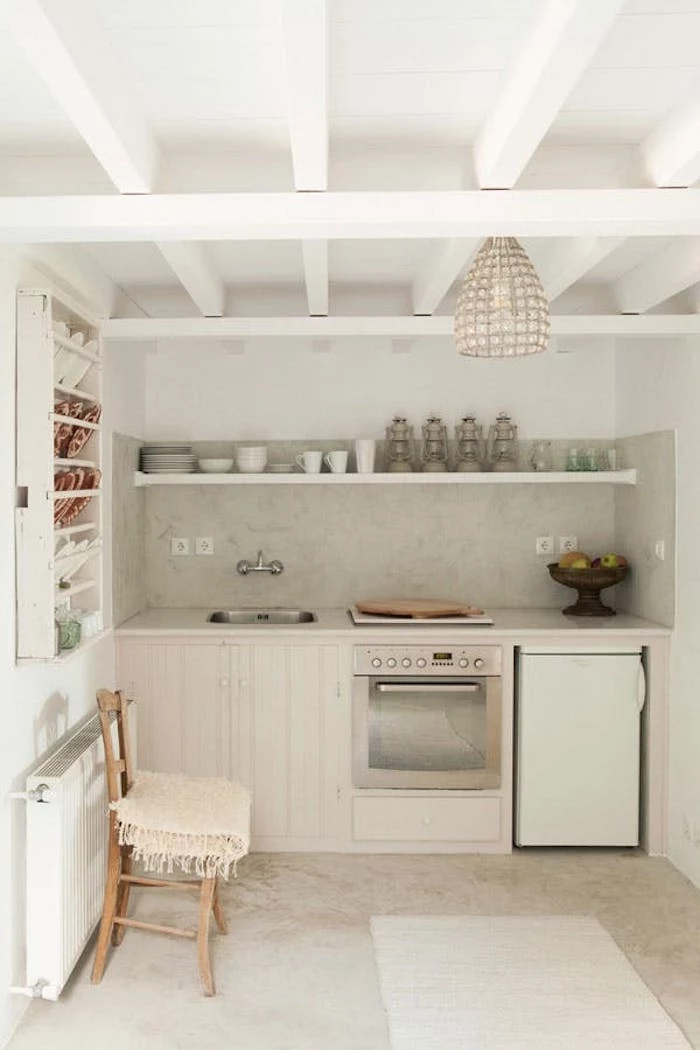
A warning on natural stone sinks: While a hand-carved travertine or marble sink is visually stunning, these porous materials can stain easily from coffee, red wine, or lemon juice. For a similar raw aesthetic with bulletproof performance, consider a composite sink. Models from Blanco in their Silgranit ‘anthracite’ or ‘concrete’ finishes offer the look of stone with modern durability.

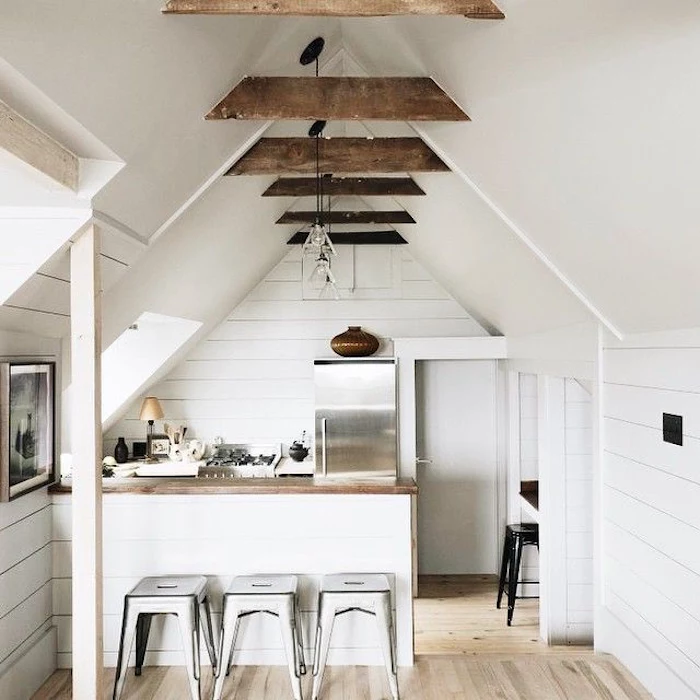
Embrace the honesty of open shelving. It forces you to be curated and tidy, but it also puts your favorite stoneware and essentials within easy reach. For ultimate authenticity, use thick, solid wood planks supported by cast-iron brackets. The shelf itself becomes as beautiful as what it holds.
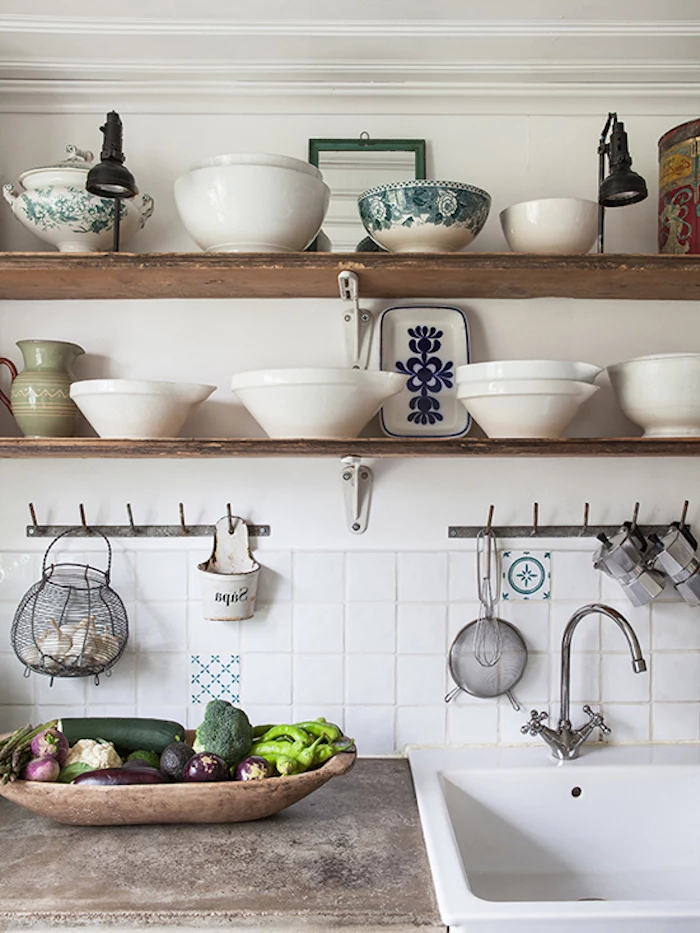
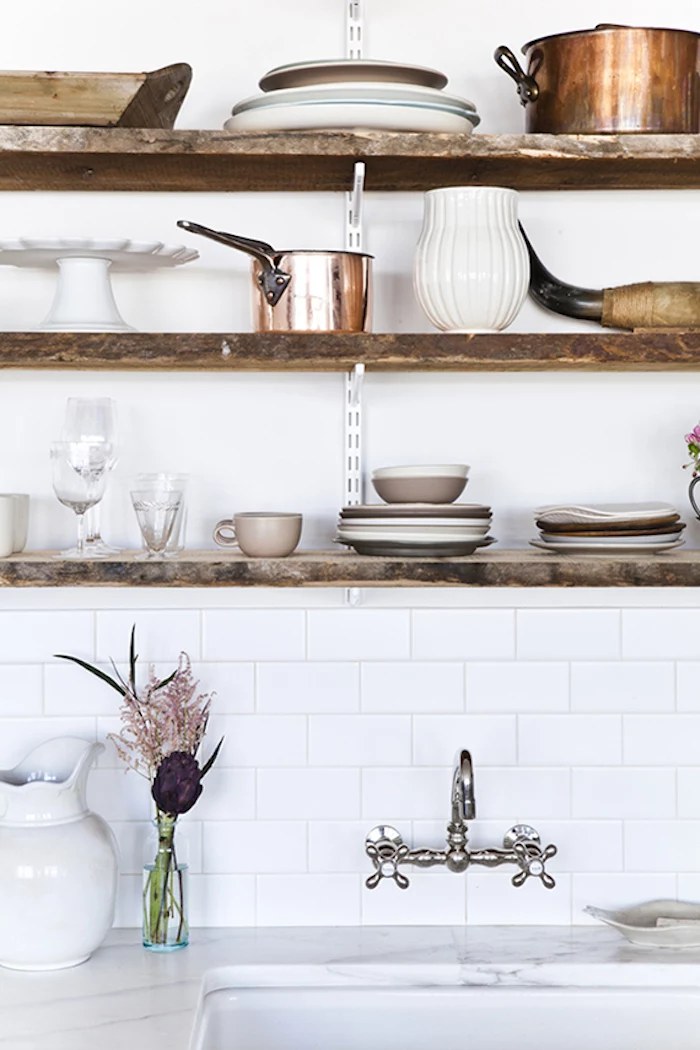
Butcher Block: End Grain vs. Edge Grain
End Grain: Made from the short ends of boards, creating a checkerboard pattern. It’s exceptionally durable and ‘self-healing’ as the wood fibers part for the knife and close back up. The professional’s choice for heavy chopping.
Edge Grain: Made from long strips of wood, creating a striped pattern. It’s more affordable but will show knife marks more readily. Better suited for general-purpose countertops.
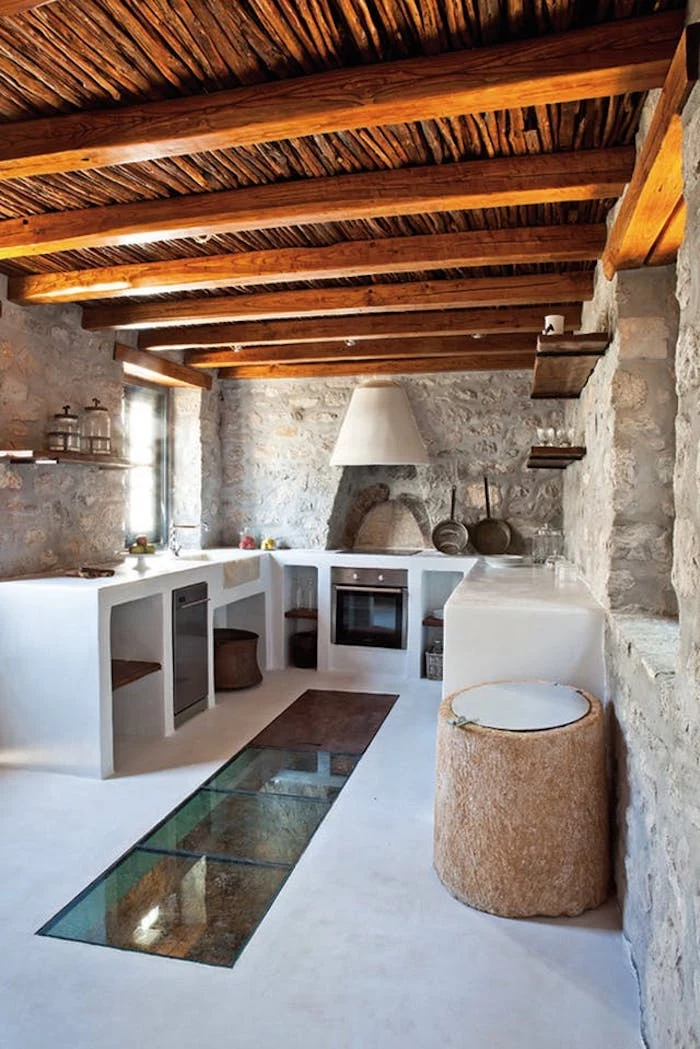

Textiles soften the hard surfaces of a rustic kitchen. Think beyond a simple tablecloth. Consider rough-spun linen dish towels from a maker like Fog Linen Work, a durable wool runner to add warmth underfoot, and simple café curtains in a natural cotton or ticking stripe to filter light without blocking the view.
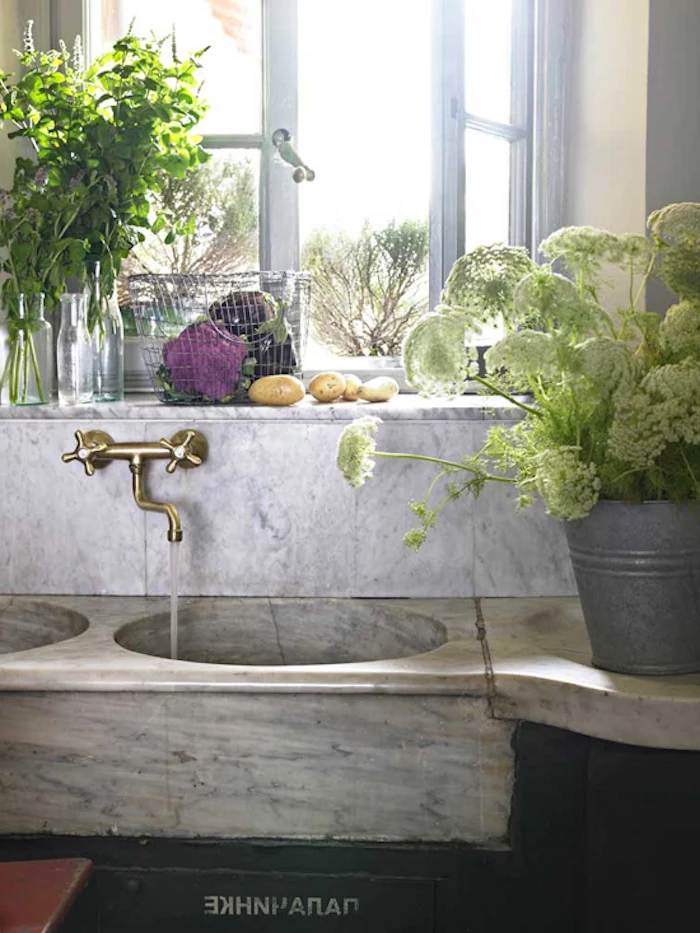
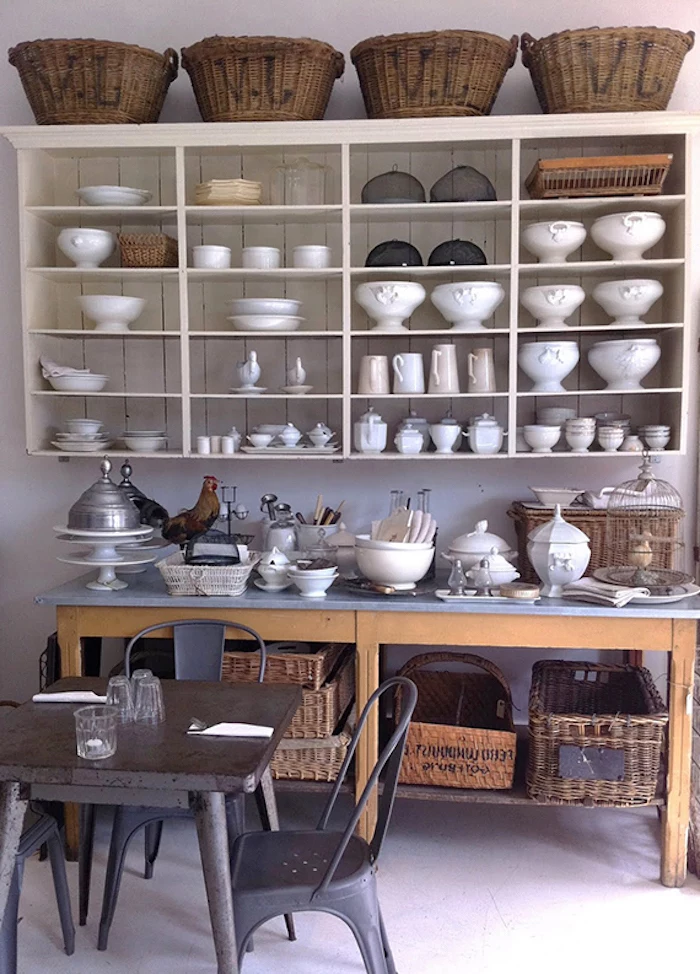
A modern, high-powered range hood can move over 600 cubic feet of air per minute (CFM).
In a rustic kitchen, this functional necessity becomes a design opportunity. Instead of stainless steel, encase the ventilation unit in a custom-built hood made of plaster, shiplap, or hammered copper to create a dramatic focal point that feels like a modern hearth.
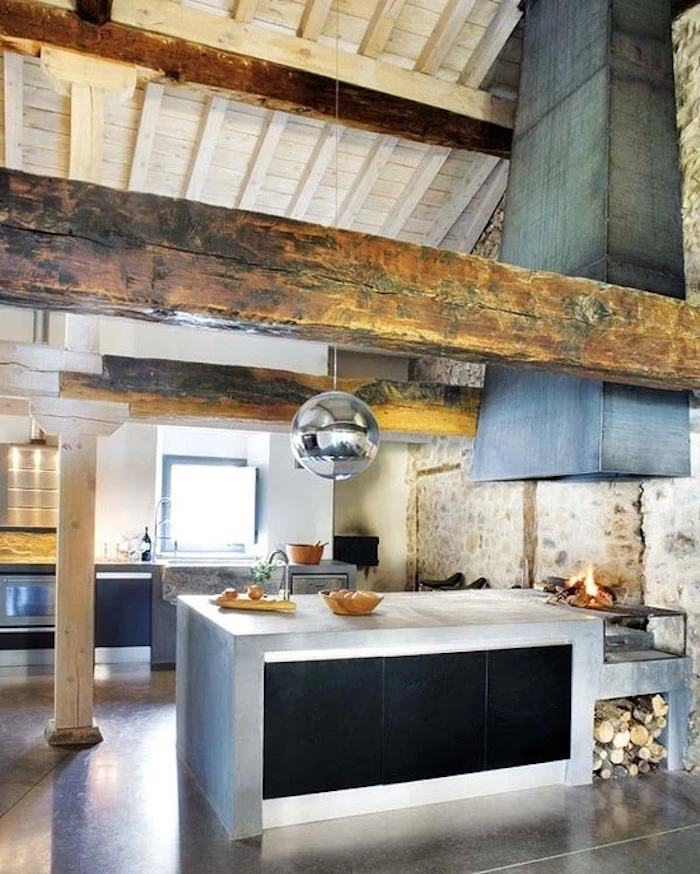
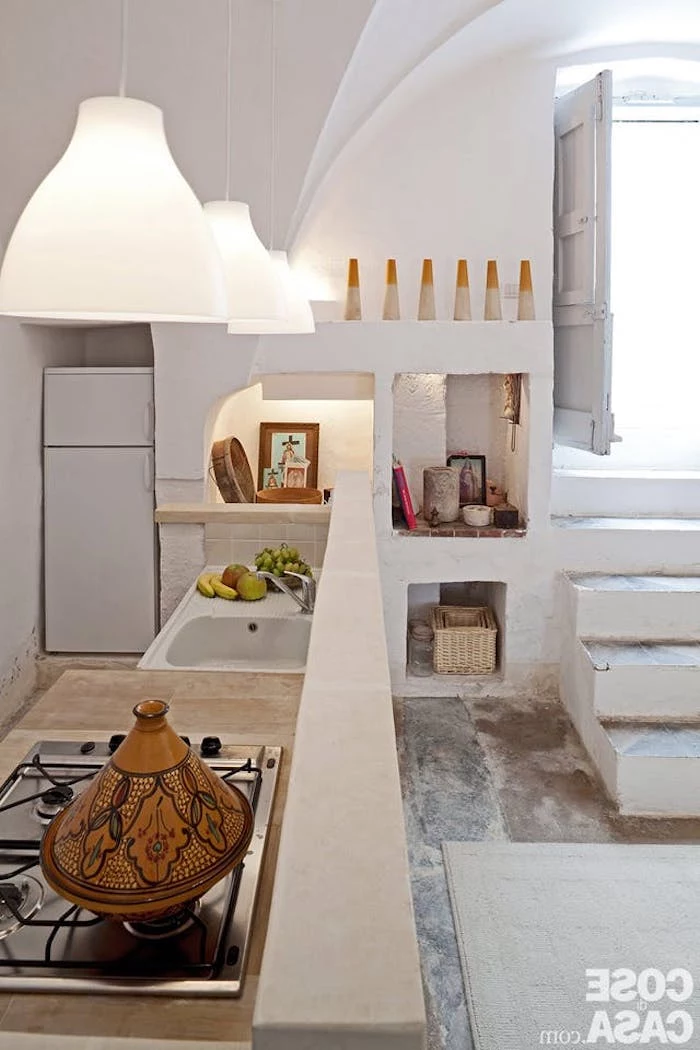
- Adds an organic, living element to the room.
- Provides fresh flavors right where you need them.
- The terracotta pots and green leaves complement the natural materials.
The feature? A simple windowsill herb garden. It doesn’t need to be complex; a few pots of hardy herbs like rosemary, thyme, and oregano in your sunniest window is all it takes.
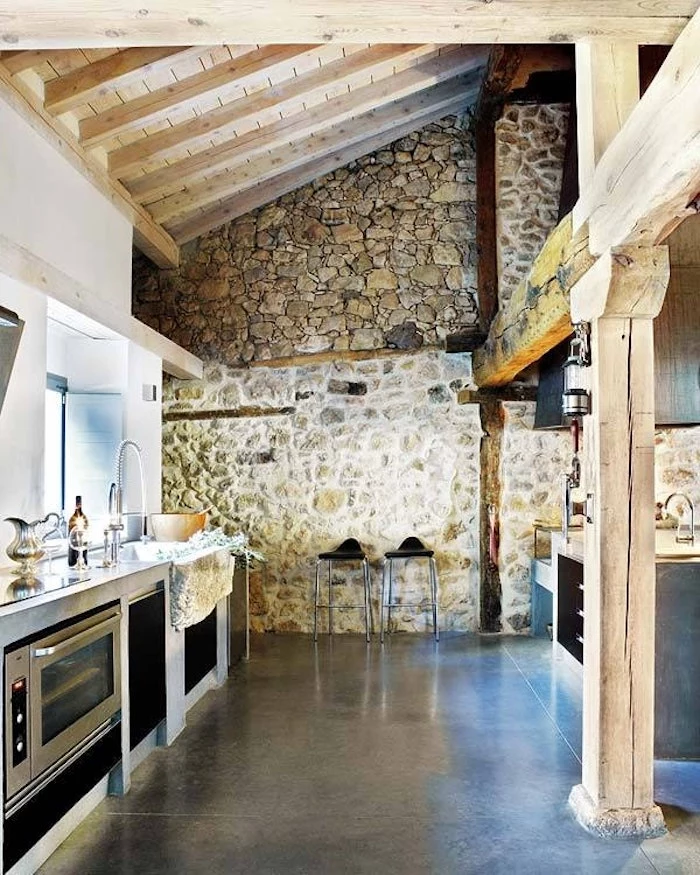
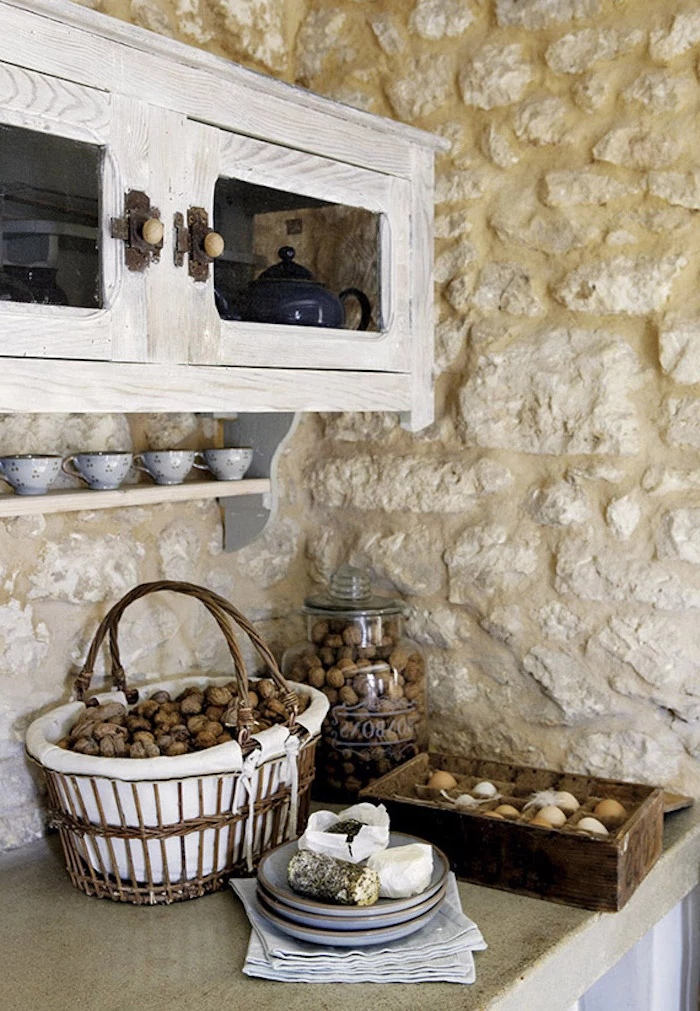
A common mistake: Ignoring scale. A delicate, spindly dining table or undersized island will look lost and out of place against solid wood cabinets and stone floors. Rustic design calls for substance. Choose furniture with visual weight and generous proportions to match the honesty of the room’s architecture.
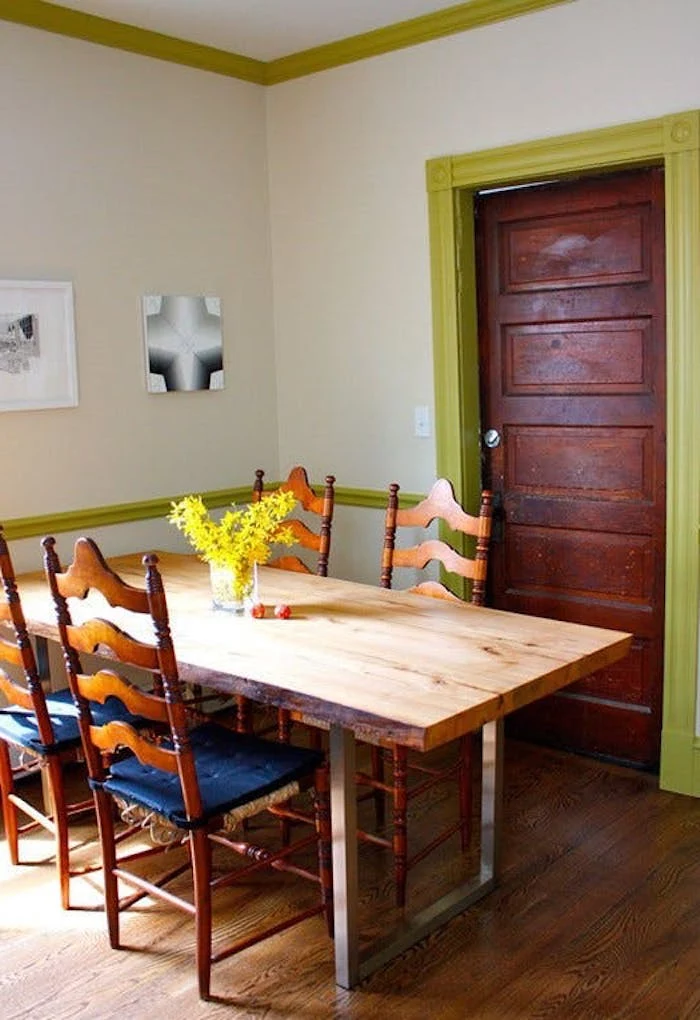
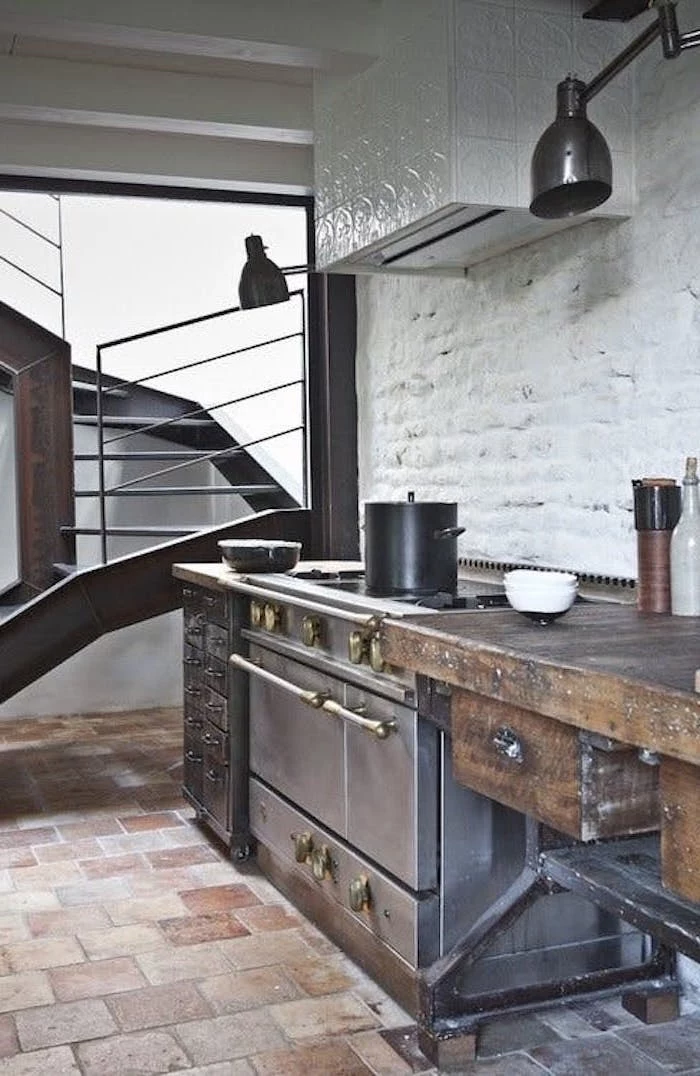
Can I get the look on a tight budget?
Absolutely. The spirit of rustic is resourcefulness. Scour flea markets and salvage yards for a worn farm table instead of a new island. Use simple, painted beadboard for a backsplash instead of expensive tile. Look for a vintage porcelain drainboard sink instead of a new fireclay model. Character is often found, not bought.
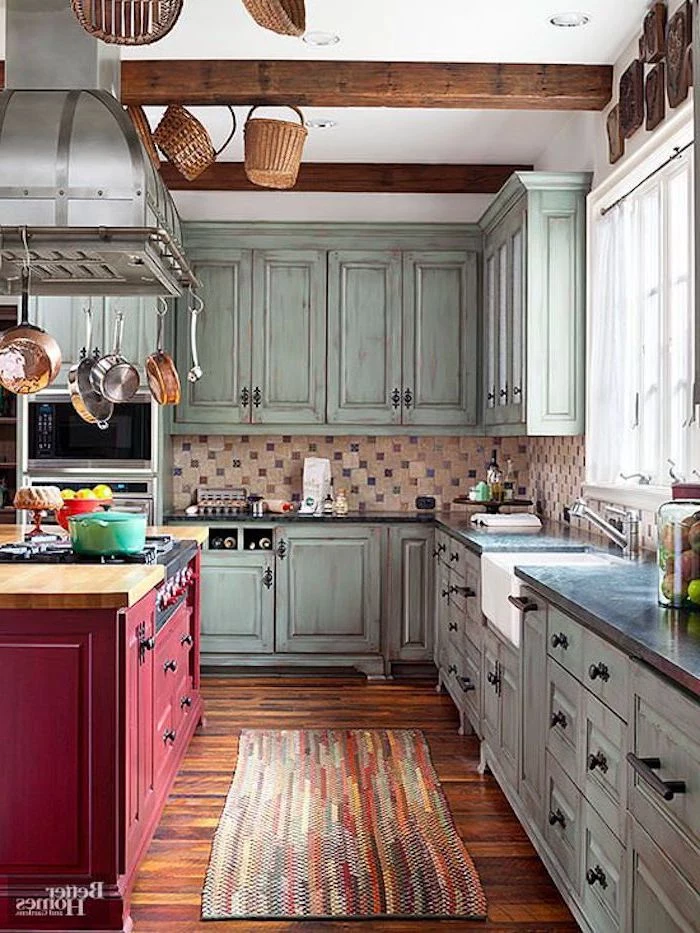
The ‘perfectly imperfect’ finish is key. For painted surfaces, resist the urge for a flawless spray finish. A hand-brushed application will leave subtle brushstrokes, adding a layer of human touch and character that feels authentic and warm, perfectly aligning with the room’s handmade ethos.

